Teaching:TUW - UE InfoVis WS 2007/08 - Gruppe 06 - Aufgabe 1 - Level of Detail
Definition[edit]
Overview[edit]
The starting point is a high resolution object. But not all of the information is important from each view or distant! The solution is to simplify these small or distant objects as much as possible. This process will even be called Level of Detail or LOD. For that the object is divided into a grid of polygons, which will be reduced step by step.
Parts[edit]
LOD is not such an easy one man process. In fact of this we will now subdivide the frameworks into four important parts:
- Discrete LOD
- Continuous LOD
- View Dependent LOD
- Hierarchical LOD
The Discrete LOD (DLOD)[edit]
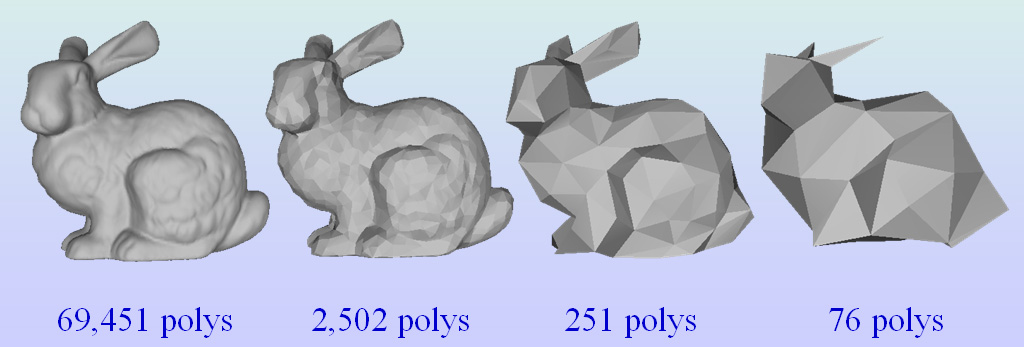
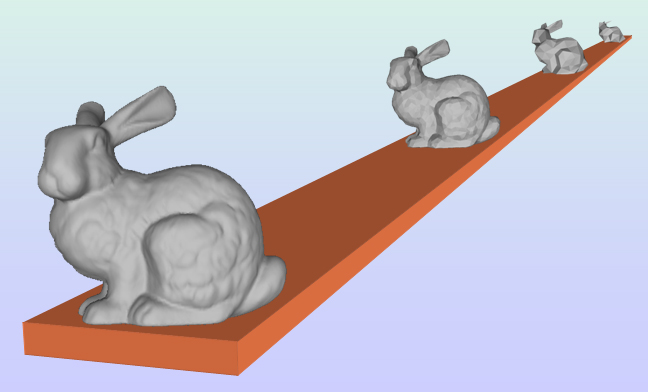
The Discrete LOD is the traditional version. The concept is to provide some different models to represent an object. Therefore it is possible to use external algorithm (normally non trivial). The idea is to divide these models in several parts, dependent on the needed Level of Detail (picture 1).
Like we have already described in the example above, it is important to think about how much information really is needed. Maximum detail of an object for close-ups and a minimum of detail for very far away objects (picture 2).
An Advantage of DLOD is that it is the simplest programming model and the run-time rendering needs only to combine the several models of the Level of Details. But there is even an unfortunately disadvantage, because sometimes are DLOD not adequate for drastic simplification. Large objects need to be subdivided and the small objects must be combined. This implementation would be very difficult even when not impossible with discrete algorithms.
Continous LOD[edit]
The discrete LOD is more or less the prototype of the Continuous LOD. It is a continuous spectrum of LODs. That means that one picture includes the information, necessary for more levels of details. These are measured by an algorithm. So it is possible to extract the best model for the actual viewpoint in real time.
Example:[edit]
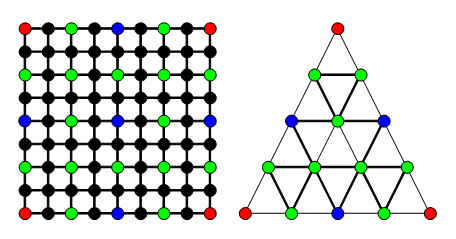
Level of Detail 1: red points
Level of Detail 2: red + blue points
Level of Detail 3: red + blue + green points
Level of Detail 4: red + blue + green + black points
View Dependent LOD[edit]
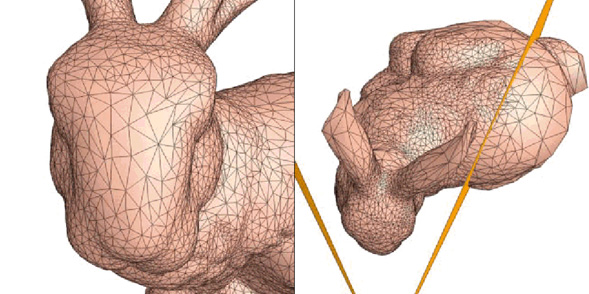
The View Dependent LOD uses the current view parameters to find the best resolution for the current view.
For example you have a robot which travels through the environment. It is only useful to show a high resolution version from things the robot is gazing at. Like the focus of the human eyes.
Hierarchical LOD[edit]
Hierarchical LOD uses the several models of the Discrete LOD and combines them to a group in a hierarchy. So it is possible to extract the important points of a whole environment.
Example:[edit]
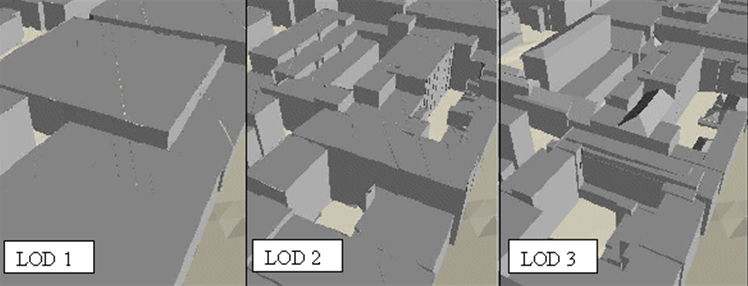
In a computer-game it is usual to zoom into the environment. Therefore it is the best solution to have some different resolutions and to morph between them. In this example you see three LODs, the first one at a very low resolution and the third one with the highest resolution mostly outgoing from the original object.
References[edit]
[1] [Clark, 197] James H. Clark. Hierarchical Geometric Models for Visible Surface Algorithms. In Proceedings of the Third Annual Conference on Computer Graphics, Interactive Techniques, and Image Processing, pages 547-554, July 14-16, 1976. Communications October 1976 of Volume 19 the ACM Number 10.
[Luebke, 2002] David Luebke. Course Real-Time Rendering. University of Virginia. Created at: September 26, 2002. Retrieved at: November 8, 2007. http://www.cs.virginia.edu/~gfx/Courses/2004/RealTime/lecture06.LOD1.ppt.
[Fischer, 2007] Matthias Fischer. Vorlesung Algorithmen in der Computergrafik SS 2007 Universität Paderborn. Retrieved at: November 8, 2007. http://wwwhni.uni-paderborn.de/fileadmin/hni_alg/lehre/SS2007/AlgoCG/algoCG_LODPM.ppt
[Reddy, 2007] Martin Reddy. Run-Time Management for LOD. Pixar Animation Studios. Retrieved at: November 8, 2007. http://lodbook.com/course/2003/Reddy_RunTime.ppt
[en.wikipedia.org] Level of Detail. Retrieved at: November 8, 2007. http://en.wikipedia.org/wiki/Level_of_detail
[de.wikipedia.org] Level of Detail. Retrieved at: November 8, 2007. http://de.wikipedia.org/wiki/Level_of_Detail
[DGL Wiki ] Level of Detail. Delphi-OpenGL-Community. Retrieved at: November 8, 2007.
http://wiki.delphigl.com/index.php/LOD
[Deussen, 2002] Oliver Deussen. Level-of-Detail. Vorlesung Computergraphik II. TU Dresden. Retrieved at: November 8, 2007. http://web.inf.tu-dresden.de/ST2/cg/pdf_daten/Informatik/HS/cg2/ss02/lod_script.pdf
[Southern and Gain] R. Southern and J. Gain. Creation and Control of Real-time Continuous Level of Detail on Programmable Graphics Hardware. Collaborative Visual Computing Laboratory University of Cape Town, South Africa. Retrieved at: November 8, 2007. http://www.cl.cam.ac.uk/~rs416/papers/southern01_CGF.pdf
[Birkholz] Hermann Birkholz. Texturing of Continuous LOD Meshes with the Hierarchical Texture Atlas. University of Rostock, Germany. Retrieved at: November 8, 2007.http://wwwicg.informatik.uni-rostock.de/~hb01/doc/Texturing%20of%20Continuous%20LOD%20Meshes%20with%20the%20Hierarchical%20Texture.pdf